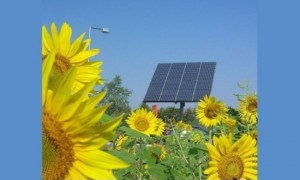
Physicists at the University of Salford, along with 12 international partners, have launched a €5 million research project that aims to develop novel types of photovoltaic (PV) cell for use in solar panels. The cells will use so-called perovskite PV technology, which has the potential to be both low-cost and extremely efficient. The project, entitled CHEOPS, aims to upscale promising initial trials of the technology to industrial and commercial levels.
The term perovskite photovoltaics refers to a novel class of materials, commonly a hybrid organic-inorganic lead or tin halide-based material, with a special crystal structure that makes possible the fabrication of extremely efficient solar cells in a simple manner and at potentially low manufacturing costs.
Large-scale
Dr Heather Yates, principal investigator for the Salford CHEOPS project said: “As researchers, we may get excited when we achieve a new efficiency record with a small cell of about 1cm2 but to prove this technology we need modules of at least 15cm2 and we need them to be stable.
“At Salford we will be employing a technique called Atmospheric Pressure Chemical Vapour Deposition to produce large-scale thin films which make up the perovskite cell. We will also consider how to produce films using tools, techniques and procedures that can readily be implemented in an industrial environment.”
In addition to upscaling the technology, researchers will also produce tandem cells – with a perovskite cell on top of a conventional silicon-based cell. Such tandem cells can harvest a broader spectrum of light than a single cell, which should lead to an increase in their efficiency further approaching the 30 per cent range.
In the longer term, existing manufacturing methods used for silicon devices might require only minor modification before being used to produce tandem cells, as the perovskite layer would simply be added on top of the conventional cell to act as an “efficiency booster”.
Renewables growth ‘vital’
Added Dr Yates: “It is essential to continually improve the attractiveness of solar as a renewable energy source. Perovskite photovoltaic technology can be an important step in this direction and the team at Salford are looking forward to sharing our findings with our academic and industrial partners.
In 2014, photovoltaic produced around 200 gigawatts of power, just 1-2 per cent of global electricity demands.
The CHEOPS Project is coordinated by CSEM, Switzerland and co-funded by the European research and innovation program Horizon 2020. It officially began in February 2016 and will end in January 2019.
Partners
The 12 partners will combine their expertise, knowledge, and resources to reach the project’s goal:
- The University of Oxford
- La Università degli Studi di Roma Tor Vergata
- EPFL
- The University of Salford
- CSEM
- Tyndall, Ireland
- INERIS
- Accelopment AP
- Fraunhofer Institute for Applied Polymer Research
- SmartGreenScans)
- Oxford Photovoltaics Ltd
- Merck KGaA